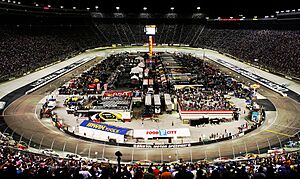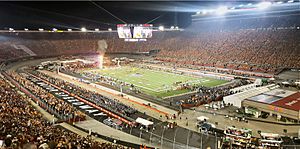Bristol Motor Speedway facts for kids
| The Last Great Colosseum | |
|---|---|

|
|

Oval (1961–present)
|
|
| Location | 151 Speedway Boulevard, Bristol, Tennessee, 37620 |
| Time zone | UTC−5 (UTC−4 DST) |
| Coordinates | 36°30′56″N 82°15′25″W / 36.5156°N 82.2569°W |
| Capacity | 146,000 |
| Owner | Speedway Motorsports (January 1996–present) Larry Carrier (July 1961–October 1977, January 1986–December 1995) |
| Operator | Speedway Motorsports (January 1996–present) |
| Broke ground | January 25, 1961 |
| Opened | July 23, 1961 |
| Construction cost | US$600,000 |
| Former names | Bristol International Raceway (1978–1996) Bristol International Speedway (1961–1978) |
| Major events | Current: NASCAR Cup Series Food City 500 (1961–present) Bass Pro Shops Night Race (1961–present) NASCAR All-Star Race (2020) NASCAR Xfinity Series SciAps 300 (1982–2020, 2025) Food City 300 (1982–present) NASCAR Craftsman Truck Series Weather Guard Truck Race (2021–present) UNOH 200 (1995–present) |
| Oval | |
| Surface | Concrete |
| Length | 0.533 mi (0.858 km) |
| Turns | 4 |
| Banking | Turns: 24–28° Straights: 4–8° |
| Race lap record | 0:14.945 ( |
| Temporary Dirt Oval (2020–2023) | |
| Surface | Clay |
| Length | 0.533 mi (0.858 km) |
| Turns | 4 |
| Banking | Turns: 16–19° Straights: 9° |
| Race lap record | 0:19.003 ( |
Bristol Motor Speedway, often called "The Last Great Colosseum," is a famous race track in Bristol, Tennessee. It's a short oval track, about 0.533 miles (0.858 km) long. Since it opened in 1961, it has hosted many exciting events. These include NASCAR races, college football games, and sprint car races.
The speedway can hold 146,000 people, making it one of the biggest sports venues in the United States. Besides the main oval, there's also a quarter-mile (0.40 km) drag strip. The track is currently owned by Speedway Motorsports, LLC.
The idea for the track came from local businessman Larry Carrier in 1961. It was built quickly and opened in July of that year. Over the years, the track changed owners a few times. In 1996, Bruton Smith bought it. Under his ownership, Bristol Motor Speedway grew a lot, becoming the huge facility it is today.
About Bristol Motor Speedway
Track Design
Bristol Motor Speedway is 0.533 miles (0.858 km) long. The turns are steeply angled, or "banked," from 24 to 28 degrees. This steep banking helps cars go very fast around the corners. The straight parts of the track are also banked, from 4 to 8 degrees.
When the track first opened, the turns were banked at 27 degrees. For a few years, the track was temporarily covered with dirt for special races. When it's a dirt track, the banking is a bit less steep, from 16 to 19 degrees. Bristol is also unique because it's the only track on the NASCAR schedule that has two separate pit road lanes for cars to stop for service.
Cool Features
When Bristol Motor Speedway first opened, it could hold 21,000 fans. It also had a press box and lots of parking. Over the years, it has grown a lot. Today, it can hold 146,000 people.
One of the most impressive features is "Colossus TV." This is a giant television screen, 30 by 63 feet (9.1 by 19.2 meters), that hangs over the middle of the track. It's one of the largest outdoor screens of its kind!
Drag Strip Next Door
In 1964, plans were made to build a drag strip next to the main oval track. This quarter-mile (0.40 km) drag strip was finished by May 1965. It has been updated several times since then, including a big renovation in 1997.
Track History
Building the Track
In 1960, Larry Carrier wanted to build a race track as part of his plans to expand recreation in the Tri-Cities, Tennessee area. He first thought about building it in Piney Flats, Tennessee, but that idea was not approved. So, he chose a different spot, which used to be a dairy farm.
Carrier and his partners drew up plans for the track on paper bags! On January 17, 1961, they announced plans for a 20,000-seat, half-mile (0.80 km) track. They also announced that two annual NASCAR races would be held there. Construction started a few days later, on January 25, 1961.
People in Tennessee were very excited about the new track. The Governor of Tennessee even declared a "Volunteer 500" week.
Early Days and Growth
The track officially opened on July 23, 1961. Two days later, it hosted its first NASCAR practice session. The track quickly became popular, with local media calling it the "best" and "fastest" half-mile track in the world.
In 1964, plans for the drag strip were announced, and it opened in June 1965. In 1969, the main track was repaved and redesigned to make it even faster. The banking in the turns was changed to make cars go over 100 miles per hour (160 km/h).
New Owners and Night Races
By the mid-1970s, Larry Carrier wanted to focus more on drag racing. So, in 1977, he sold the track to Lanny Hester and Gary Baker for $1 million. The new owners renamed it "Bristol International Raceway." They also made improvements and brought back the longer 500-lap NASCAR races.
A big change happened in 1978: Bristol held its first ever night race! Temporary lights were installed, and this became a popular tradition.
Later, Gary Baker bought out Hester's share. Then, in 1981, Warner W. Hodgdon bought part of the track. He planned to increase the seating capacity to 50,000. By 1983, Hodgdon owned the entire track. However, he soon faced financial difficulties. The track was almost put up for auction, but Hodgdon filed for bankruptcy. Despite this, the track's events continued thanks to Larry Carrier.
Larry Carrier Returns
In 1986, Larry Carrier bought the track back for $4.5–5 million. He sold the drag strip to help pay for it. Carrier immediately announced more renovations, including new grandstands.
Throughout the 1980s, Bristol Motor Speedway became incredibly popular. Races often sold out months in advance. The track expanded to 50,000 seats and brought in a lot of money for the local economy.
The track was repaved several times in the late 1980s and early 1990s. Drivers sometimes complained about the surface being rough. After the 1992 Food City 500, Carrier decided to repave the track with concrete instead of asphalt, which was a big change.
Bruton Smith's Era and Huge Growth
Even though Larry Carrier said he wouldn't sell the track, motorsports owner Bruton Smith was very interested. After some negotiations, Carrier sold the track to Smith for $26 million on January 23, 1996. The track was then renamed "Bristol Motor Speedway."
Many fans and local businesses were worried that Smith might move Bristol's NASCAR races to bigger tracks he owned. But Smith denied these rumors. Instead, he announced plans to increase the seating capacity from 81,000 to 120,000. By 1997, Bristol Motor Speedway became the largest sports arena in Tennessee.
The expansion continued. In 1999, the Kulwicki Tower was built, adding 12,000 seats and bringing the total capacity to 147,000. In 2000 and 2001, the track even tried holding dirt races on a temporary surface, but these were stopped because of how much cleanup they required.
Track Changes and Colossus TV
In 2002, a new pedestrian tunnel was built to connect the grandstands to the infield. In 2006, the track announced another repave, which happened in 2007. This repave changed the banking to a "variable-banking" system, with turns ranging from 24 to 30 degrees. The racing surface was also made wider.
Some fans and drivers didn't like the new surface as much because it changed the style of racing Bristol was known for. In 2012, the track changed the banking again to try and bring back the old racing style.
In 2015, Bristol announced the building of "Colossus TV," the huge television screen mentioned earlier. Construction finished in April 2016. That same year, the track started using a special traction compound called PJ1 TrackBite on the lower part of the track to help create more exciting multi-lane racing.
Events at Bristol
Racing Events
NASCAR Races
Bristol Motor Speedway hosts two big NASCAR weekends each year. These include the NASCAR Cup Series races: the Food City 500 and the Bass Pro Shops Night Race.
The Food City 500 first took place in 1961. From 2020 to 2023, this race was held on a temporary dirt surface to make it more exciting. But in 2024, it returned to its original concrete surface. The Bass Pro Shops Night Race, which started in 1961, was Bristol's first major event. In 1978, it became a night race, which is now a popular tradition.
Bristol also hosts races for the NASCAR Xfinity Series and NASCAR Craftsman Truck Series. These are support races that happen during the Cup Series weekends. In 2020, Bristol also hosted the special NASCAR All-Star Race one time.
Other Races
- Bristol hosted a round of the 2013 Global RallyCross Championship in 2013.
- From 2022 to 2023, YouTuber Lawrence Garrett Mitchell, also known as Cleetus McFarland, held an annual car festival called "Cleetus and Cars" at the track, which included races.
Other Sports
American Football Games
Bristol Motor Speedway has hosted American gridiron football games several times. In 1961, it held an exhibition game between the Washington Redskins and the Philadelphia Eagles.
In 2013, it was announced that a major college football game, called the Battle at Bristol, would be played at the track in 2016. This game was between the Tennessee Volunteers and the Virginia Tech Hokies. It took place on September 10, 2016, and the Volunteers won. A week later, another college football game was played there between the East Tennessee State Buccaneers and the Western Carolina Catamounts.
Baseball Games
Bristol Motor Speedway hosted a Major League Baseball game between the Atlanta Braves and Cincinnati Reds from August 2-3, 2025. This was the first regular-season MLB game ever played in the state of Tennessee. The Braves won the game 4–2.
Other Uses
Bristol Motor Speedway has also been used to help the public in many ways:
- In 2002, it became a temporary high school for students when their school had to close.
- In the early 2010s, a medical clinic was held at the track to provide healthcare.
- The track has served as a safe place for people to go during hurricanes, like Hurricane Irma in 2017 and Hurricane Florence in 2018.
- It was also used as a COVID-19 vaccine distribution center.
In 2021, YouTuber Jimmy Donaldson, known as MrBeast, held a game of tag at the track with a $500,000 prize for the winner.
Lap Records
As of September 2024, here are some of the fastest official race lap records at Bristol Motor Speedway:
| Category | Time | Driver | Vehicle | Event |
|---|---|---|---|---|
| Oval: 0.858 km (1961–present) | ||||
| NASCAR Cup | 0:14.945 | Kyle Larson | Chevrolet Camaro ZL1 | 2018 Food City 500 |
| NASCAR Truck | 0:15.350 | Christian Eckes | Chevrolet Silverado | 2023 UNOH 200 |
| ARCA Menards | 0:15.622 | Landen Lewis | Chevrolet Camaro SS | 2024 Bush's Beans 200 |
| NASCAR Xfinity | 0:15.650 | Cole Custer | Ford Mustang | 2019 Alsco 300 |
| Late model | 0:16.574 | Stewart Friesen | Late model | 2021 Bristol Throwdown |
| Temporary Dirt Oval: 0.858 km (2020–2023) | ||||
| NASCAR Truck | 0:19.003 | Stewart Friesen | Toyota Tundra NASCAR | 2021 Pinty's Truck Race on Dirt |
| NASCAR Cup | 0:19.261 | Kyle Larson | Chevrolet Camaro ZL1 | 2022 Food City Dirt Race |
See also
 In Spanish: Bristol Motor Speedway para niños
In Spanish: Bristol Motor Speedway para niños




